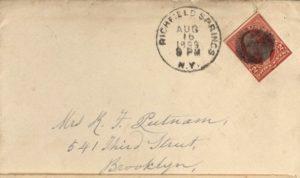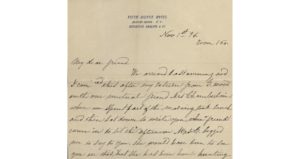Transcription Methods


Josephine Louise Newcomb wrote in a legible handwriting all the way to the end of her long life. Her style might best be characterized as Round Hand (shown below), a style popularized in England in the late 1600s, and taught in North America in later centuries.

By and large, JLN’s handwriting was consistent over the years. Some of the letters from the early 1880s seem to be a bit different, thus reflecting her ongoing grief until, in 1886, she became in her own words, less “a wretched woman” consumed by daughter Sophie’s absence.
In our transcriptions of the letters, we have made every effort to render her words as accurately as possible. Spelling, capitalization, and punctuation are reproduced as they appear in the original. While her spelling was excellent with few antiquated or misspelled examples, her capitalization and punctuation were idiosyncratic. Misspellings are transcribed uncorrected. Punctuation marks are transcribed as observed, although distinguishing between a comma and a period, or colon and semi-colon at times proved difficult. Perhaps the biggest challenge to transcribing her letters lay in untangling abbreviations. See for help with that here.
The indentation of paragraphs, and the placement of dates, salutations, closings and signature are reproduced on the page as closely as possible to the original. However, page margins and the number of pages in a letter have not been maintained.
Inserted text written between lines is included in superscript. Inserted text is identified by a subscripted carrot [^] only when one was used by JLN. Inserted text in the margin is noted as such by the editors. Her frequent underlining of words or a few letters in a word is reproduced as nearly as possible; word or words underlined two or three times for emphasis are noted by the editors. Her use of dashes, sometimes mid-line, sometimes bottom-line, are standardized as em dashes.
Only occasionally do the editors supply a word or words in brackets where an omission occurs in the original letter. If there is some doubt as to the correct transcription of a name, word or words, the name, word, or words in question are placed in brackets followed by a question mark e.g., [Lexington?]. If after several close readings, a word, words or phrases remain unrecognizable, the editors indicate such by inserting italicized text in brackets [word illegible] or [words illegible]. The three oldest letters, dated in the 1880s, presented the biggest challenge to translation because of their darkened condition, and as mentioned above, perhaps for other reasons as well.
Mrs. Newcomb appears not to have had her own personal stationery although occasionally she would center her initials J.L.N. at the top of a blank page. The majority of her letters were written on the stationery of the hotel or resort where she was staying, thereby allowing us a record of her travels and residences. The editors have attempted to provide the information available on the letterhead in a fashion resembling that of the original. JLN also favored the One Cent Postal Card for brief correspondences.
Unless otherwise noted, the slips (newspaper articles), and other enclosures she mentions did not survive the years and are unavailable.
